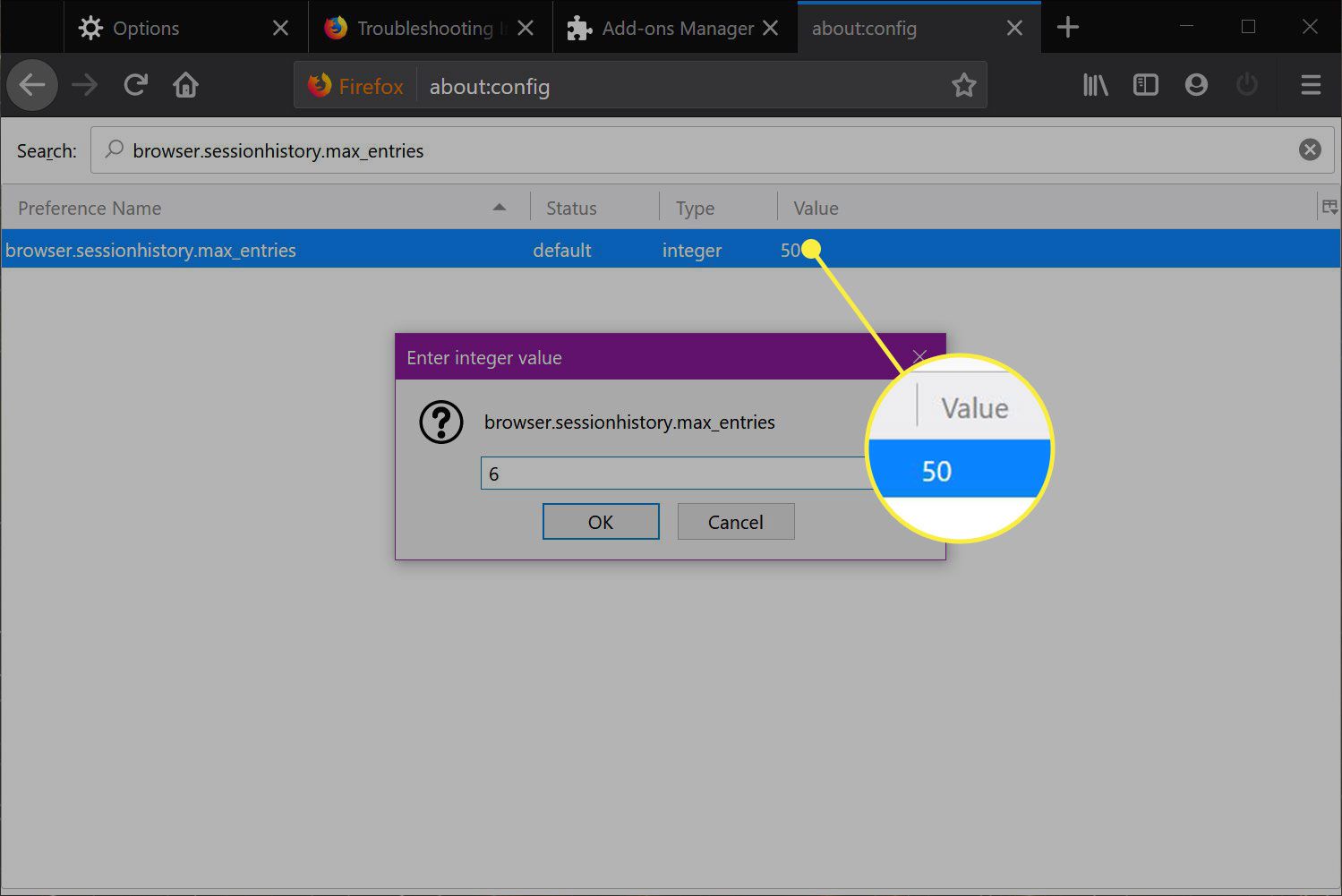Introduction
Welcome to our guide on how to limit Firefox RAM usage! If you’re an avid Firefox user, you may have noticed that the browser can sometimes consume a significant amount of your computer’s memory, leading to sluggish performance or even system slowdowns. In this article, we’ll provide you with practical tips and tricks to help you reduce Firefox’s memory footprint and optimize its performance.
Firefox, being one of the most popular web browsers worldwide, offers plenty of features and customization options that contribute to its versatility. However, these features can come at a cost. The browser’s memory usage tends to increase as you open more tabs, install add-ons, and engage in resource-intensive browsing activities. Fortunately, there are several strategies and settings you can employ to keep Firefox’s RAM usage in check and ensure a smoother browsing experience.
Understanding how Firefox utilizes RAM is crucial in effectively managing its memory consumption. By knowing how different actions and configurations impact memory usage, you can make informed decisions to optimize performance without sacrificing functionality. In the following sections, we’ll delve into the various factors affecting Firefox’s RAM usage and provide you with practical steps to mitigate excessive memory consumption, enabling you to strike the right balance between performance and functionality.
It’s important to note that each user’s browsing habits and system configuration can vary, so the effectiveness of these tips may differ from person to person. However, implementing these suggestions should help improve your Firefox experience by reducing memory usage and enhancing overall performance. Without further ado, let’s explore the methods to limit Firefox RAM usage and enhance your browsing experience!
Assessing Firefox’s RAM Usage
Before diving into the methods to reduce Firefox’s RAM usage, it’s important to understand how to assess the current memory usage of the browser. By monitoring the memory consumption, you can identify the areas where optimizations are needed and measure the effectiveness of the changes you make.
Firefox provides built-in tools that allow you to assess its RAM usage easily. To access these tools, follow these steps:
- Open Firefox and type “about:memory” in the address bar.
- Press Enter to navigate to the “about:memory” page.
- On this page, you’ll find detailed information about Firefox’s memory usage, including the memory consumed by tabs, add-ons, and other elements. You can also find a “Measure” button that allows you to initiate a memory usage snapshot.
By clicking the “Measure” button, Firefox will generate a report that provides an overview of the browser’s memory consumption in real-time. This report can help you identify memory-intensive tabs or add-ons that are impacting Firefox’s performance.
Additionally, you can also use third-party tools like Task Manager on Windows or Activity Monitor on Mac to assess Firefox’s memory usage. These tools provide an overall view of the system resources being utilized by the browser, including CPU, memory, and disk usage. You can access them by pressing Ctrl + Shift + Esc on Windows or Command + Space and searching for “Activity Monitor” on Mac.
Regularly monitoring Firefox’s RAM usage is crucial in identifying any memory-related issues and taking appropriate action. By keeping an eye on its memory consumption, you can address any excessive memory usage promptly, ensuring an optimized browsing experience.
Understanding the Impact of RAM Usage
RAM, or Random-Access Memory, is a crucial component of your computer system that stores data that is actively used by programs and processes. When it comes to web browsers like Firefox, the amount of RAM being used can have a significant impact on overall performance.
Excessive RAM usage by Firefox can lead to various issues, such as slow response times, freezing, and even system crashes. Here are some of the common impacts of high RAM usage:
- Sluggish Performance: When Firefox consumes a large amount of RAM, it can slow down your entire system. This is because the operating system needs to continuously transfer data between RAM and the hard disk, leading to delays in processing and overall sluggishness.
- Browser Crashes: Excessive memory usage may cause Firefox to become unstable and crash frequently. This can result in data loss and disrupt your browsing experience.
- Unresponsive Tabs: When you have multiple tabs and extensions open in Firefox, high RAM usage can cause individual tabs to become unresponsive or take longer to load. This can be frustrating and hinder your productivity.
- Resource Competition: If Firefox is using a significant amount of your system’s RAM, it may lead to resource competition with other programs and processes. This can result in reduced performance for other applications running on your computer.
By understanding the impact of RAM usage on Firefox’s performance, you can see the importance of controlling and optimizing its memory consumption. It allows you to prioritize resources effectively and ensure a smoother browsing experience.
By implementing the strategies we’ll explore in the following sections, you can reduce Firefox’s RAM usage and mitigate the negative impacts listed above. Remember, finding the right balance between functionality and resource efficiency is essential for a seamless browsing experience.
Tips to Limit Firefox’s RAM Usage
Now that we understand the importance of managing Firefox’s RAM usage and its impact on performance, let’s explore some effective tips to limit its memory consumption. These strategies will help optimize the browsing experience and ensure smooth functionality without sacrificing essential features.
- Update Firefox to the Latest Version: Keeping your browser up to date ensures that you have the latest performance improvements and bug fixes. Newer versions of Firefox often come with optimizations that can help reduce memory usage.
- Disable Unused Add-ons and Extensions: Add-ons and extensions can be resource-intensive and contribute to high RAM usage. Disable or uninstall any unnecessary add-ons to minimize the memory footprint of Firefox.
- Use Content Process Limit Feature: Firefox offers a feature called “Content Process Limit” that allows you to control the number of processes used by the browser. By limiting the number of content processes, you can reduce RAM usage.
- Reduce the Number of Open Tabs and Windows: Each open tab and window in Firefox contributes to its memory usage. Close any unnecessary tabs and windows to free up RAM and improve performance.
- Optimize Firefox’s Memory Caching: Adjust Firefox’s memory caching settings to strike the right balance between performance and memory usage. You can do this by accessing the “about:config” page and modifying certain preferences, such as “browser.cache.disk.enabled” and “browser.cache.memory.enable”.
- Disable Hardware Acceleration: Disabling hardware acceleration in Firefox can help reduce memory usage, especially if you’re experiencing performance issues. You can find this option under the “Preferences” or “Settings” menu of Firefox.
- Clear Cache and Cookies Regularly: Clearing the cache and cookies of Firefox regularly can free up space in memory and improve overall performance. You can do this by navigating to the “Privacy & Security” section in Firefox’s settings.
- Enable Automatic Session Restore: Firefox has a feature that remembers your open tabs and restores them on startup. While convenient, it can also contribute to higher memory usage. Consider enabling automatic session restore only when necessary to conserve memory.
- Use Lightweight Themes: Some Firefox themes can be heavy on system resources. Switching to lightweight or default themes can help reduce RAM usage and improve performance.
Implementing these tips and adjusting Firefox’s settings as per your requirements should significantly reduce its RAM usage. However, it’s important to keep in mind that these optimizations may vary depending on your system configuration, browsing habits, and the specific version of Firefox you’re using. Regularly monitor Firefox’s memory usage to ensure that it stays within acceptable limits and adjust the settings accordingly.
By following these strategies, you can maximize the efficiency of Firefox, enhance its performance, and enjoy a smoother browsing experience with reduced RAM usage.
Update Firefox to the Latest Version
Ensuring that you are using the most up-to-date version of Firefox is essential for optimizing its performance and reducing RAM usage. Mozilla regularly releases updates that include bug fixes, security enhancements, and performance optimizations. By keeping your browser updated, you can take advantage of these improvements and potentially reduce memory consumption.
Updating Firefox to the latest version is a straightforward process. Here’s how you can do it:
- Open Firefox on your computer.
- Click on the three horizontal lines in the upper-right corner of the browser window to open the menu.
- From the menu, click on “Help” and then select “About Firefox”.
- A new window will appear, displaying information about your current Firefox version and whether an update is available.
- If an update is available, click on the “Restart to update Firefox” button to initiate the update process.
- Firefox will download and install the latest version automatically. Once the process is complete, it will relaunch with the updated version.
Updating Firefox ensures that you have access to the latest stability and performance optimizations. These updates often include enhancements to memory management and resource usage, which can help reduce RAM consumption and improve overall browser performance.
It’s a good practice to enable automatic updates for Firefox to ensure you always have the latest version installed. You can do this by going to the “Preferences” or “Settings” menu of Firefox and navigating to the “General” or “Update” section. From there, you can choose “Automatically install updates” or a similar option.
By regularly updating Firefox, you can take advantage of the latest optimizations and improvements, reducing memory usage, and ensuring a smoother browsing experience.
Disable Unused Add-ons and Extensions
Add-ons and extensions can enhance the functionality of Firefox, allowing you to personalize your browsing experience. However, these additional features can also contribute to increased RAM usage. Disabling any unused or unnecessary add-ons and extensions can help reduce Firefox’s memory footprint and improve its performance.
To disable add-ons and extensions in Firefox, follow these steps:
- Open Firefox and click on the three horizontal lines in the upper-right corner to access the menu.
- From the menu, select “Add-ons” to open the Add-ons Manager.
- In the Add-ons Manager, you’ll see a list of all the installed add-ons and extensions. Review the list and identify any add-ons that you no longer use or need.
- For each unused add-on or extension, click on the “Disable” button next to it. This will deactivate the add-on and prevent it from running in the background.
- After disabling the unnecessary add-ons, restart Firefox to apply the changes.
By disabling unused add-ons and extensions, you can reduce the memory overhead and eliminate any unnecessary processes running in the background. This frees up valuable resources and helps optimize Firefox’s performance.
It’s important to regularly evaluate the add-ons and extensions you have installed in Firefox. Remove any that you no longer use or need, as they can continue to consume memory even when not actively in use. Additionally, consider disabling add-ons temporarily if you notice a significant increase in RAM usage when using certain features.
While add-ons can be beneficial, it’s crucial to strike a balance between functionality and resource optimization. By disabling unused add-ons and extensions, you can minimize memory usage, streamline Firefox’s performance, and enjoy a faster, more responsive browsing experience.
Use Content Process Limit Feature
Firefox offers a powerful feature called “Content Process Limit” that allows you to control the number of processes used by the browser. By adjusting this setting, you can effectively manage Firefox’s memory consumption and improve its overall performance.
By default, Firefox uses a separate process for each tab you open, which can contribute to increased RAM usage. However, you can limit the number of content processes to a specific number, which helps reduce memory usage.
Here’s how you can use the Content Process Limit feature in Firefox:
- Open Firefox and type “about:config” in the address bar.
- Press Enter to navigate to the advanced configuration page.
- You might see a warning message indicating that you should proceed with caution. Click on the “Accept the Risk and Continue” button.
- In the search bar, type “dom.ipc.processCount” and press Enter. This will display the preference entry for controlling the content process limit.
- Double-click on the “dom.ipc.processCount” preference to modify its value.
- Enter the desired number of content processes you want Firefox to use (e.g., 4 for four processes).
- Click on the “OK” button to save the changes.
After adjusting the content process limit, Firefox will only use the specified number of processes for tabs and windows. This helps reduce memory usage since fewer processes are running simultaneously.
Keep in mind that setting a low content process limit may impact the functionality of certain websites or web applications that rely on separate processes. If you encounter any issues with specific websites, consider increasing the content process limit or resetting it to the default value.
Using the Content Process Limit feature in Firefox allows you to have better control over the memory resources consumed by the browser. By optimizing the number of content processes, you can reduce Firefox’s memory usage and ensure a more efficient browsing experience.
Reduce the Number of Open Tabs and Windows
Having multiple tabs and windows open in Firefox can increase its memory usage, especially if each tab contains complex webpages or media-rich content. To optimize Firefox’s performance and reduce RAM usage, it’s important to minimize the number of open tabs and windows.
Here are a few tips to help you manage and reduce the number of open tabs and windows in Firefox:
- Close unnecessary tabs: Review your open tabs and close any that you are no longer actively using. This helps free up memory and improves browser responsiveness.
- Use bookmarks: Instead of keeping numerous tabs open for future reference, bookmark the websites you want to revisit later. This way, you can close the tabs and easily access the websites through your bookmarks.
- Utilize tab groups or containers: Firefox offers features like tab groups or containers that allow you to organize tabs into different categories. Utilizing these features can help keep your tabs organized and make it easier to manage multiple open tabs.
- Use tab suspension extensions: There are extensions available for Firefox that can automatically suspend inactive tabs, effectively reducing their memory footprint. These extensions can help optimize memory usage without losing access to your tabs.
Reducing the number of open tabs and windows in Firefox can have a significant impact on RAM usage. By closing unnecessary tabs and utilizing features like bookmarks and tab groups, you can free up memory and improve the overall performance of the browser.
While it’s convenient to have multiple tabs open for quick access to different websites, it’s essential to strike a balance between functionality and resource optimization. By keeping the number of open tabs to a minimum, you can ensure that Firefox runs smoothly and efficiently, providing a better browsing experience.
Optimize Firefox’s Memory Caching
Adjusting Firefox’s memory caching settings is a useful strategy to reduce RAM usage and optimize the browser’s performance. By optimizing the way Firefox utilizes memory caching, you can strike the right balance between performance and memory consumption.
Here are a few steps to help you optimize Firefox’s memory caching:
- Access the about:config page: In the address bar of your Firefox browser, type “about:config” and press Enter. This will open the advanced configuration page.
- Search for memory-related preferences: In the search bar on the about:config page, type “browser.cache” to filter the preferences related to memory caching.
- Modify the cache preferences: There are two preferences related to disk and memory caching that you can consider adjusting: “browser.cache.disk.enabled” and “browser.cache.memory.enable”.
- To disable disk caching and only use memory caching, set the value of “browser.cache.disk.enabled” to “false”. This will prevent Firefox from saving cached data to the hard disk, reducing disk I/O and speeding up the browser.
- To enable memory caching, ensure that the value of “browser.cache.memory.enable” is set to “true”. This allows Firefox to store cached data in memory, which can improve the loading speed of frequently visited websites.
- Modify cache size (optional): If you want to further optimize memory caching, you can adjust the cache size. Look for the preference “browser.cache.memory.capacity” and modify its value. Increasing the value allocates more memory for caching, potentially improving performance for complex webpages. However, be cautious not to allocate excessive memory, which may lead to increased RAM usage.
By fine-tuning Firefox’s memory caching settings, you can reduce its reliance on disk caching and allocate more memory for storing frequently accessed data. This can result in faster webpage loading times and decreased RAM usage.
Remember that modifying these preferences requires caution, as incorrect changes may affect Firefox’s stability or performance. If you’re not comfortable with making advanced configuration changes, it’s best to consult official Mozilla resources or seek assistance from knowledgeable individuals.
Optimizing Firefox’s memory caching provides an effective technique to manage RAM usage and enhance the browser’s performance. By adjusting caching settings to suit your needs, you can strike the right balance between performance and memory consumption in Firefox.
Disable Hardware Acceleration
Hardware acceleration is a feature in Firefox that offloads certain tasks to your computer’s GPU (Graphics Processing Unit) to improve performance. While hardware acceleration can provide a boost in speed for certain systems, it can also contribute to increased RAM usage. If you’re experiencing high memory consumption in Firefox, disabling hardware acceleration may help alleviate the issue.
Here’s how you can disable hardware acceleration in Firefox:
- Open Firefox and click on the three horizontal lines in the upper-right corner to access the menu.
- From the menu, select “Preferences” (on macOS) or “Options” (on Windows).
- In the Preferences or Options page, click on the “General” tab.
- Scroll down to the “Performance” section.
- Uncheck the box next to “Use recommended performance settings”.
- Uncheck the box next to “Use hardware acceleration when available”.
- Close the Preferences or Options page and restart Firefox to apply the changes.
Disabling hardware acceleration shifts the processing burden from the GPU to the CPU, potentially reducing memory usage. This can be beneficial on systems where GPU-related tasks put a strain on memory resources.
Keep in mind that disabling hardware acceleration may not be necessary for all users. In some cases, hardware acceleration can provide performance benefits. If you haven’t experienced high RAM usage or performance issues in Firefox, it’s recommended to leave hardware acceleration enabled.
For users who encounter significant memory consumption or experience issues related to GPU-related tasks, disabling hardware acceleration can be an effective solution. By turning off this feature, you can potentially reduce Firefox’s memory usage and enhance the overall performance of the browser.
Clear Cache and Cookies Regularly
Over time, Firefox accumulates cached data and cookies, which can take up valuable space in your computer’s memory. Clearing the cache and cookies regularly not only helps free up storage but can also improve Firefox’s performance and reduce RAM usage.
Here’s how you can clear the cache and cookies in Firefox:
- Open Firefox and click on the three horizontal lines in the upper-right corner to access the menu.
- From the menu, select “Options” (on Windows) or “Preferences” (on macOS).
- In the Preferences or Options page, click on the “Privacy & Security” tab.
- Scroll down to the “Cookies and Site Data” section, and click on the “Clear Data” button.
- In the pop-up window, make sure the checkboxes next to “Cookies and Site Data” and “Cached Web Content” are selected.
- Click on the “Clear” button to remove the selected data.
Clearing the cache removes temporary files stored by websites, while clearing cookies removes data that websites store on your computer. By regularly clearing both cache and cookies, you can eliminate unnecessary data and reduce Firefox’s memory usage.
Keep in mind that clearing cookies will sign you out of websites and remove any site preferences or saved login information. After clearing the cache and cookies, you may need to re-enter usernames and passwords for websites.
Additionally, you can configure Firefox to clear the cache and cookies automatically when you close the browser. To enable this feature:
- On the same “Privacy & Security” tab as before, under the “History” section, click on the drop-down menu next to “Firefox will”.
- Select “Use custom settings for history”.
- Check the box next to “Clear history when Firefox closes”.
- Click on the “Settings” button next to it, and make sure “Cache” and “Cookies” are selected.
- Click on the “OK” button to save the changes.
Configuring Firefox to clear the cache and cookies automatically helps maintain optimal performance and keeps memory usage in check.
Regularly clearing the cache and cookies is an effective strategy to reduce Firefox’s memory usage and improve performance. By removing unnecessary data, you can optimize the browser’s memory consumption and enjoy a faster and smoother browsing experience.
Enable Automatic Session Restore
Firefox offers a convenient feature called “Automatic Session Restore” that allows you to restore your previous browsing session automatically when you launch the browser. While this feature can be useful for retaining your tabs and windows, it can also contribute to increased RAM usage. By enabling automatic session restore, you can strike a balance between convenience and memory optimization.
Here’s how you can enable automatic session restore in Firefox:
- Open Firefox and click on the three horizontal lines in the upper-right corner to access the menu.
- From the menu, select “Options” (on Windows) or “Preferences” (on macOS).
- In the Preferences or Options page, click on the “General” tab.
- Under the “Startup” section, check the box next to “Restore previous session”.
- Close the Preferences or Options page to save the changes.
Enabling automatic session restore ensures that Firefox remembers and reopens your tabs and windows from the previous browsing session. However, keeping numerous tabs and windows open can contribute to increased RAM usage. It’s important to strike a balance between convenience and memory optimization.
If you frequently work with a large number of tabs and experience high RAM usage, consider disabling automatic session restore and manually managing your browsing session. This involves closing unused tabs and only restoring the necessary ones to conserve memory resources.
Remember, disabling automatic session restore means that you’ll need to manually open your desired tabs and windows each time you launch Firefox. However, this trade-off can help reduce memory usage and contribute to a smoother browsing experience.
By enabling or disabling automatic session restore based on your specific needs, you can optimize Firefox’s memory usage and tailor the browsing experience to your preferences.
Use Lightweight Themes
Customizing the appearance of Firefox with themes can be a fun way to personalize your browsing experience. However, some themes can be heavy on system resources, including memory. By opting for lightweight themes, you can reduce the impact on Firefox’s memory usage while still enjoying a visually appealing browser interface.
Here’s how you can use lightweight themes in Firefox:
- Open Firefox and click on the three horizontal lines in the upper-right corner to access the menu.
- From the menu, select “Add-ons” to open the Add-ons Manager.
- In the Add-ons Manager, click on the “Themes” tab.
- Browse through the available themes and look for ones that are labeled as “lightweight” or have minimal design elements.
- Select the lightweight theme you want to use and click on the “Enable” or “Add to Firefox” button.
- Firefox will download and apply the selected lightweight theme.
Using lightweight themes helps minimize the impact on Firefox’s memory usage because they typically do not include resource-intensive visual effects or elements. These themes are designed to provide a streamlined and efficient browsing experience without sacrificing aesthetics.
While using lightweight themes is recommended for reducing memory usage, keep in mind that the actual impact on memory can vary depending on various factors, including the specific theme and your system configuration. It’s always a good idea to monitor Firefox’s RAM usage after applying a new theme to ensure that it aligns with your memory optimization goals.
If you’re experiencing high memory usage or performance issues, consider switching to a lightweight theme or using the default theme provided by Firefox. These themes are built to be resource-efficient, ensuring the browser utilizes memory more efficiently and reduces unnecessary strain on your system.
By opting for lightweight themes, you can maintain a visually pleasing browsing experience while keeping Firefox’s memory usage under control.
Conclusion
Managing Firefox’s RAM usage is crucial for optimizing its performance and ensuring a smooth browsing experience. High memory consumption can lead to sluggishness, unresponsive tabs, and even system instability. By implementing the tips and techniques discussed in this article, you can successfully reduce Firefox’s memory footprint and enhance its efficiency.
First and foremost, updating Firefox to the latest version ensures that you benefit from performance optimizations and bug fixes that can help reduce memory usage. Disabling unused add-ons and extensions eliminates unnecessary processes and frees up valuable memory resources. Adjusting the content process limit helps control the number of processes used by Firefox, reducing RAM consumption.
Managing the number of open tabs and windows prevents excessive memory usage, while optimizing Firefox’s memory caching settings allows you to balance performance and memory conservation. Disabling hardware acceleration can reduce RAM usage on systems where GPU-related tasks strain the memory, and clearing the cache and cookies regularly eliminates unnecessary data and improves performance.
Enabling automatic session restore can be convenient but may contribute to higher memory usage. For users experiencing significant RAM usage or performance issues, disabling this feature may be beneficial. Lastly, using lightweight themes helps reduce the impact on memory while still allowing for personalization.
Remember that finding the ideal balance between functionality and resource optimization may require some experimentation and monitoring. The effectiveness of these strategies may vary depending on your system configuration, browsing habits, and the specific version of Firefox you’re using. Regularly monitoring Firefox’s memory usage and adjusting the settings accordingly will help ensure optimal performance.
By following these tips to limit Firefox’s RAM usage, you can enjoy a smoother, more responsive browsing experience while minimizing the strain on your computer’s memory resources. With a well-optimized Firefox, you’ll be able to navigate the web efficiently and comfortably.

























